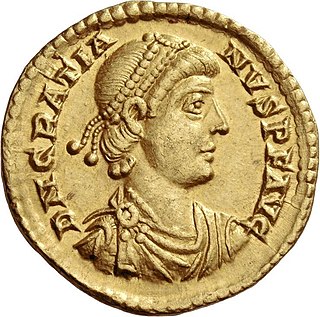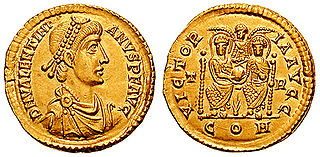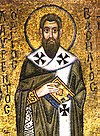The 400s decade ran from January 1, 400, to December 31, 409.
The 380s decade ran from January 1, 380, to December 31, 389.
Year 377 (CCCLXXXI) was a common year starting on Friday of the Julian calendar. At the time, it was known as the Year of the Consulship of Syagrius and Eucherius. The denomination 381 for this year has been used since the early medieval period, when the Anno Domini calendar era became the prevalent method in Europe for naming years.
The 430s decade ran from January 1, 430, to December 31, 439.
The 270s decade ran from January 1, 270, to December 31, 279.
The 360s decade ran from January 1, 360, to December 31, 369.
The 330s decade ran from January 1, 330, to December 31, 339.
The 350s decade ran from January 1, 350, to December 31, 359.
The 370s decade ran from January 1, 370, to December 31, 379.
The 240s decade ran from January 1, 240, to December 31, 249.
Year 388 (CCCLXXXVIII) was a leap year starting on Saturday of the Julian calendar. At the time, it was known as the Year of the Consulship of Augustus without colleague. The denomination 388 for this year has been used since the early medieval period, when the Anno Domini calendar era became the prevalent method in Europe for naming years.

Year 386 (CCCLXXXVI) was a common year starting on Thursday of the Julian calendar. At the time, it was known as the Year of the Consulship of Honorius and Euodius. The denomination 386 for this year has been used since the early medieval period, when the Anno Domini calendar era became the prevalent method in Europe for naming years.

Year 384 (CCCLXXXIV) was a leap year starting on Monday of the Julian calendar. At the time, it was known as the Year of the Consulship of Ricomer and Clearchus. The denomination 384 for this year has been used since the early medieval period, when the Anno Domini calendar era became the prevalent method in Europe for giving names to years.

Year 383 (CCCLXXXIII) was a common year starting on Sunday of the Julian calendar. At the time, it was known as the Year of the Consulship of Merobaudes and Saturninus. The denomination 383 for this year has been used since the early medieval period, when the Anno Domini calendar era became the prevalent method in Europe for naming years.
Year 380 (CCCLXXX) was a leap year starting on Wednesday of the Julian calendar. At the time, it was known as the Year of the Consulship of Augustus and Augustus. The denomination 380 for this year has been used since the early medieval period, when the Anno Domini calendar era became the prevalent method in Europe for naming years.

Year 375 (CCCLXXV) was a common year starting on Thursday of the Julian calendar. At the time, it was known in Rome as the Year after the Consulship of Augustus and Equitius. The denomination 375 for this year has been used since the early medieval period, when the Anno Domini calendar era became the prevalent method in Europe for naming years.

Year 359 (CCCLIX) was a common year starting on Friday of the Julian calendar. At the time, it was known as the Year of the Consulship of Eusebius and Hypatius. The denomination 359 for this year has been used since the early medieval period, when the Anno Domini calendar era became the prevalent method in Europe for naming years.

Gratian was emperor of the Western Roman Empire from 367 to 383. The eldest son of Valentinian I, Gratian was raised to the rank of Augustus as a child and inherited the West after his father's death in 375. He nominally shared the government with his infant half-brother Valentinian II, who was also acclaimed emperor in Pannonia on Valentinian's death. The East was ruled by his uncle Valens, who was later succeeded by Theodosius I.

The Theodosian dynasty was a Roman imperial family that produced five Roman emperors during Late Antiquity, reigning over the Roman Empire from 379 to 457. The dynasty's patriarch was Theodosius the Elder, whose son Theodosius the Great was made Roman emperor in 379. Theodosius's two sons both became emperors, while his daughter married Constantius III, producing a daughter that became an empress and a son also became emperor. The dynasty of Theodosius married into, and reigned concurrently with, the ruling Valentinianic dynasty, and was succeeded by the Leonid dynasty with the accession of Leo the Great.

The Valentinian dynasty was a ruling house of five generations of dynasts, including five Roman emperors during late antiquity, lasting nearly a hundred years from the mid fourth to the mid fifth century. They succeeded the Constantinian dynasty and reigned over the Roman Empire from 364 to 392 and from 425 to 455, with an interregnum (392–423), during which the Theodosian dynasty ruled and eventually succeeded them. The Theodosians, who intermarried into the Valentinian house, ruled concurrently in the east after 379.









